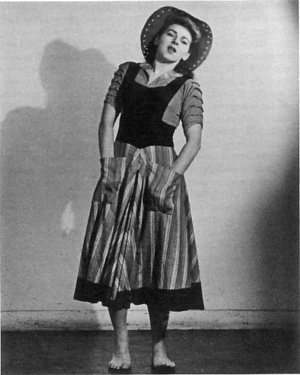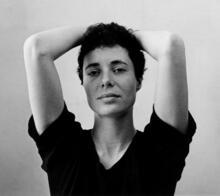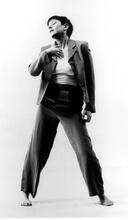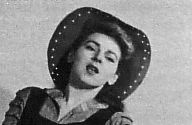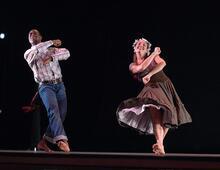Sophie Maslow
A leader of the New Dance Group and a member of the Dudley-Maslow-Bales Trio, Sophie Maslow was among the generation of dancers involved in the 1930s labor movement. Maslow saw her work as inspired by a personal heritage rather than by political ideology; she believed that dance “could enrich the lives of workers in and of itself.” Her earliest solo, Themes from a Slavic People (1934), was praised in the left-wing press for its lyricism and evocation of folk culture. In 1942 Maslow developed her first masterpiece, Folksay – a folk medley interspersed with Woody Guthrie ballads. After WWI, she choreographed a piece called The Village I Knew (1950) based on Sholem Aleichem’s writings on Russian-Jewish village life. Above all, Maslow wanted her dances to be of the common people.
Born in New York in 1911, Sophie Maslow was one of those modern dance pioneers who “could march from the Workers’ Bookstore to the Martha Graham Studio in no time at all, a fact that made it possible to fight the spiritual wars of revolutionary politics and modern dance almost simultaneously” (Graff).
Origins & Influences
Maslow was a member of the Martha Graham Company from 1931 to 1940, a leader of the New Dance Group, a choreographer and performer in the Dudley-Maslow-Bales Trio, and director of the the Sophie Maslow Dance Company. Maslow was a founding member of the American Dance Festival and the New York City Center Dance Theater. She was married to Ben (Max) Blatt; the couple had one daughter.
Maslow boasted that her father, a Moscow socialist printer, gave her the revolutionary spirit and ability to work with a group. Like many other modern dance pioneers, Maslow attended the Neighborhood Playhouse, that unique cradle of dance that produced the early Graham Company. She also went to Camp Kinderland, a Workman’s Circle camp. One of several Jewish modern dancers who went to and later worked at Camp Kinderland, Maslow joked that without Camp Kinderland there would have been no modern dance. As a member of the Martha Graham Company from 1931 to 1940, she appeared in such Graham productions as Primitive Mysteries(1931), American Document (1938), and Letter to the World (1940).
The start of Maslow’s dance career coincided with the Great Depression and the labor movement of the 1930s. Workers’ groups along a wide political spectrum were formed, and dancers joined, in turn forming the Workers’ Dance League and the New Dance Group. The dancers, often divided by ideology and allegiances, struggled to reconcile revolutionary and bourgeois dance—dance that proclaimed the workers’ movement of the future and also dance inherited from traditional forms, even incorporating the new, personalized forms developed by Martha Graham. “Their muscles (and joints) and sinews were trained to express power—artistic and social. Clenched fists, aggressive lunges, and themes of hard physical work were common in revolutionary dance” (Graff).
The Source of Her Dance
Maslow saw her work as inspired by a personal heritage rather than by politics or ideology. Her classes at the International Ladies Garment Workers Union were devoid of political content. “Movement was not a privileged activity.” Although dance could and did communicate left-wing ideology, “dance was perceived as a form of expression that could enrich the lives of workers in and of itself,” according to Maslow.
Another controversy that emerged in the 1930s among dancers and critics was the source of dance itself. Most staunch left-wingers believed that folk dance was the ultimate source. Maslow, with her lyric ability and strong Graham training, was able to master an idiom that brought the adaptation of folk dancing to the concert stage. This was folk dancing as only a trained dancer could perform it. Her earliest solo, Themes from a Slavic People(Bartok, 1934), was praised in the left-wing press for its lyricism and evocation of folk culture. Also applauded were Two Songs About Lenin(1935), inspired by Soviet music, and the film Three Songs About Lenin.Stacey Pricket remarks that, “Even if Maslow herself was not drawn to political themes, the evocation of the Soviet Union in her dances touched a responsive chord in the immigrants and new Americans who were heavily represented among the era’s radicals.” Maslow’s work also received praise from Edna Ocko in the Daily Worker. She was described as having “quiet strength and power [that] grows more effective with each successive appearance.”
With Anna Sokolow, Maslow participated in Workers’ Dance League concerts in 1934, choreographing Death of a Tradition and Challenge to the music of Lopatnikoff. In 1936, she choreographed May Day March. With Jane Dudley, another member of the Martha Graham Company, she danced Satiric Suite in 1937 and Women of Spain in 1938. Ever a good Louis Horst student, she too produced a program of preclassic dances in 1941.
The American Spirit: Folksay
The first example of her signature work, produced in 1941, featured dances to American folk music that depicted the American experience. To the music of Woody Guthrie, Maslow danced the songs of the migratory workers in Dust Bowl Ballads. In 1942, one year later, she developed her first masterpiece, Folksay, a folk medley based on verses from Carl Sandburg’s The People, Yes, interspersed with ballads sung by Woody Guthrie.
What better way to heal the wounds of those difficult war years than the celebration of the American spirit that Folksay was—and is? Even sixty years after its premiere, college students still know “On Top of Old Smoky” and “Sweet Betsy from Pike” and identify with the free-swinging, open gestures of greeting and romance, and the down-to-earth feeling that fills the work.
Folksay was performed in 1993 at the New Dance Group Gala Concert, held at La Guardia High School of Performing Arts in New York by the Alvin Ailey Repertory Ensemble. Dance critic Edwin Denby praised the work: “The audience... is invariably delighted with Folksay. They take it perhaps as the reflection of a lovely summer day, and that is what it really is.” Margaret Lloyd, one of the earliest dance writers, called it “radiantly outflung, joyous and free ... the whole is simple and heart-warming and endearing.”
If “popular” means “of the common people,” Maslow wanted her dances to be popular. She wished dance to have as direct an impact upon as wide an audience as the theater and film do. She believed that the artists are part of, not apart from everyone. Because folk dancing grows out of the common experience of large groups of people the world over, she danced in folk terms. Her dances followed instinct with folk feeling. They are modern in form, and lean toward theatrical presentation.
Post-Holocaust: The Village I Knew
After World War II, the destruction of folk traditions, so revered by Russian-Jewish immigrants, finally had an impact. The people were gone, and with them the traditions were vanishing as well. In 1950, Maslow sought out the writings on Russian-Jewish village life by Sholem Aleichem and choreographed The Village I Knew. It was first performed at the American Dance Festival in New London, Connecticut, by the New Dance Group. Long before Jerome Robbins amplified those stories into Fiddler on the Roof,Maslow built seven episodes, each depicting village life, the celebration of SabbathShabbat, and the exodus following a pogrom. The program notes state: “In Czarist times Jewish communities were frequently uprooted by the authorities and the people driven from their homes. The Village I Knew depicts a series of scenes culminating in the despairing, hopeless flight of people once again made homeless.”
Maslow restaged The Village I Knew for a variety of companies, including Batsheva in Israel. She relates that the young Israelis were reluctant to dance these memories of the “old country.” “Later,” she says, “it became easier for them to accept and enjoy them.” Village was performed in London in 1991 as part of “After the Ark: A Celebration of Jewish Culture in Dance, Music and Song.” The festival was staged by Jane Dudley upon her retirement from the London Contemporary Dance School.
The Dudley-Maslow-Bales Trio
Jane Dudley, Sophie Maslow, and Bill Bales formed a unique trio that emerged from the Bennington Summer School and the New Dance Group. The New Dance Group survived the politicized 1930s, the period in which “dance was a weapon in the class struggle,” and went on to fulfill its promises to bring dance to the masses. Only a very few members of the group were professional dancers; most were blue-collar workers who came for recreation. When other classes were unaffordable, the New Dance Group charged only fifty cents a month for membership—and threw in a lesson in Marxism. In the 1940s, one could study many styles of modern dance, ballet, “ethnic dance,” choreography and, later, notation. There were children’s classes as well. Hundreds of people taught, studied, and even slept in the New Dance Group studios. Maslow was an important part of the New Dance Group, teaching children and adults, choreographing and dancing.
The Dudley-Maslow-Bales Trio brought warmth and humor to modern dance in a way that other choreographers could not. Most notable is The Lonely Ones, based on William Steig’s cartoons and choreographed by Dudley in collaboration with Maslow and Bales. Other Trio works include Bach Suite(1942), As Poor Richard Says (1943), Caprichos (1942), Furlough, and Passional (choreographed by Dudley). Each member of the Trio contributed dances “for and about the people.”
Later Years
In later years, Maslow formed the Sophie Maslow Dance Company and continued to develop dances on Jewish themes. After The Village I Knew, people assumed she was primarily a Jewish choreographer, often forgetting her years in the Graham Company. In 1956, she commemorated the Warsaw Ghetto in Anniversary at the 92nd Street YMHA. Like Sokolow, she staged many “Bonds for Israel” Madison Square Garden productions. In 1965, for the annual Lit. "dedication." The 8-day "Festival of Lights" celebrated beginning on the 25th day of the Hebrew month of Kislev to commemorate the victory of the Jews over the Seleucid army in 164 B.C.E., the re-purification of the Temple and the miraculous eight days the Temple candelabrum remained lit from one cruse of undefiled oil which would have been enough to keep it burning for only one day.Hanukkah festival, she produced her version of The Dybbuk, which was later staged for the Harkness Ballet (1965). She also choreographed from the Book of Ruth and Ladino Suite. Other works include Manhattan Transfer (ADF, 1953); Celebration, a suite of dances based on Israeli songs (YMHA, 1954); and Prologue. (1959).
Maslow long continued her active life; even in her eighties she was often called upon to stage performances in synagogues and Jewish community centers. She traveled to many parts of the world, enjoying the loyal admiration of students, colleagues, and friends. One close friend was choreographer Anna Sokolow, with whom she shared a lifetime of performing. New York Times dance critic Anna Kisselgoff gave a rave review of the speech Maslow made at Sokolow’s April 1995 birthday tribute. As usual, Maslow was sharing her splendid spirit with her friends.
Sophie Maslow died in Manhattan on June 25, 2006, at the age of 95.
Baum, Charlotte, Paula Hyman, and Sonya Michel. The Jewish Woman in America. New York: Doubleday, 1976
Chujoy, Anatole, and P.W. Manchester. The Dance Encyclopedia. New York: Simon & Schuster, 1967
Clarke, Mary, and David Vaughan. The Encyclopedia of Dance & Ballet. New York: Putnam, 1977
Dance Magazine (June 1956, April 1969, April 1985, and April 1991)
Dance Observer (November 1943 and October 1946)
Denby, Edwin. Dance Writings. New York: A.A. Knopf, 1986
Garafola, Lynn. Of, By, and For the People: Dancing on the Left in the 1930’s. (Studies in Dance History – Book 5). New York: Society of Dance History Scholars, 1994
Graff, Ellen. “Dancing Red: Art and Politics.” Studies in Dance History 5, no. 1 (1994)
Harris, Joanna G. “From Tenement to Theater: Three Dance Pioneers.” Judaism 45, no. 3 (1996)
Lloyd, Margaret. The Borzoi Book of Modern Dance. New York: A.A. Knopf, 1949
Martin, John. America Dancing. New York: Dodge, 1936
Martin, John. The Dance. New York: Tudor, 1946
Martin, John. John Martin’s Book of the Dance. New York: Tudor, 1963
McDonagh, Don. The Complete Guide to Modern Dance. New York: Doubleday, 1976
Maslow, Sophie. Interview by author. Interview by Elizabeth Kendell. Library and Museum of the Performing Arts at Lincoln Center, September 1976
Morgan, Barbara. Martha Graham. 1941
The New Dance Group. Souvenir Program. June 11, 1993
Rossen, Rebecca. Dancing Jewish: Jewish Identity in American Modern and Postmodern Dance. New York: Oxford University Press, 2014
Schlundt, Christena L. Tamiris: A Chronicle of Her Dance Career, 1927–1955. New York: New York Public Library, 1972
“The Season in Review.” Dance News (June 1964 and February 1965)
Warren, Larry. Anna Sokolow: The Rebellious Spirit. New Jersey: Princeton Book Co. Pub., 1991

